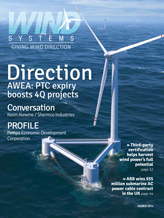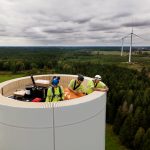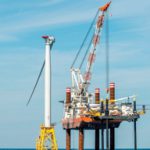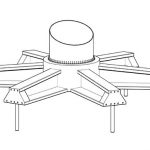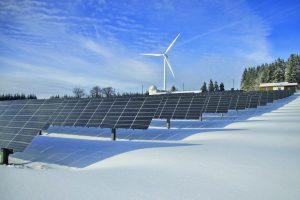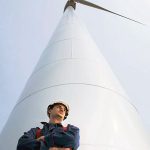The big story of 2012 was a record number of megawatts installed—over 13,000, in fact. Meanwhile, the American Wind Energy Association’s recently released Fourth Quarter Market Report showed that 2013 ended with a bang of another kind—in the area of construction starts. At the end of 2013 there were more U.S. wind power megawatts under construction than ever in history, with over 12,000 megawatts (MW) of new generating capacity in the process of getting built. Those megawatts were reflected in the strong uptick in turbine orders discussed in this space last month.
The PTC Factor
The dynamics that set the stage for 2013 were cemented in 2012, when (as mentioned last month) the threatened expiration of the PTC at the end of that year caused the supply chain to dramatically slow down from a dearth of orders, even as project developers turned in a record year, completing wind farms prior to the scheduled expiration.
The result for 2013 was that developers needed months to ramp up their project pipeline, while supply-chain factories gradually started seeing the orders come back in and could begin ramping back up themselves. As a result, a record 12,000-plus megawatts were under construction at the end of the year.
The one-year extension for the first time required that projects must start construction, rather than be completed, by year end. This policy tweak was a must because the industry needed time to ramp back up after the PTC did not get extended until Jan. 1, 2013. As a result of the past two years’ dynamics, while the industry turned in record numbers of under-construction megawatts, the project completion tally for 2013 totaled 1,084 MW.
Beyond the PTC: Other Trends
Aside from the PTC, a key driver to American wind energy’s success is that, remarkably, it is now 43 percent cheaper than it was in 2009. The resulting competitive rates for wind energy have gotten utilities’ attention, to say the least. In another sign of the industry’s strength, fourth-quarter tallies show that last year a record number of power purchase agreements (PPAs) were signed, as utilities continued to display ever-increasing understanding of not only wind power’s cost-competitiveness, but the ease with which it can be successfully integrated onto the U.S. grid. The more than 60 gigawatts of total installed wind power as of 2013 made up an important part of the U.S. power supply last year, with wind actively supporting the grid both in day-to-day operations and in times of extreme stress on the power system—specifically during the winter months that were characterized by extreme cold snaps that strained the system and even shut down fossil plants.
As wind delivers, utilities want more. At least 60 PPAs for nearly 8,000 MW were signed by utilities and corporate purchasers in 2013, of which 5,200 MW have not yet started construction. Figure 1
In 2013, as utilities inked PPAs, they regularly expressed enthusiastic support for wind energy and its benefits. “With these long-term power purchase agreements, we’re adding a significant amount of Oklahoma wind energy, bringing more diversity to our fuel mix, and doing so at a price that will provide substantial savings for our customers,” said Stuart Solomon, president and CEO of AEP-Public Service Co. of Oklahoma, in a statement regarding the utility’s purchase of nearly 600 MW of wind.
Drilling down a bit deeper in the fourth-quarter numbers reveals where the most activity is. Some of the states poised for major growth in wind energy in coming years include Texas, Iowa, Kansas, North Dakota and Michigan.
On the supply-chain side, meanwhile, there are now over 5,600 MW of turbine orders placed, with major manufacturing facilities active in places such as Colorado, Kansas, Iowa and South Dakota. U.S. manufacturing production capacity has ramped up dramatically, and in fact the largest turbine order in the history of the U.S. wind industry was placed in the Fourth Quarter of 2013. The 1,050-MW order, which was placed by MidAmerican, was secured by original equipment manufacturer Siemens Energy. The turbine manufacturer’s Fort Madison, Iowa, facility will produce all the blades, while the nacelles and hubs will be assembled at the Siemens plant in Hutchinson, Kan.
Thus, as the industry continues to seek the same kind of long-term policy stability under which other industries operate, it keeps advancing. The ramp-up, from construction starts to supply-chain action, is expected to keep the industry busy well beyond 2014.
This work was supported in part by the U.S. Department of Energy’s Advanced Research Project Agency–Energy (ARPA-E), the Harvard School of Engineering and Applied Sciences, the National Science Foundation (NSF) Extreme Science and Engineering Discovery Environment (OCI-1053575), an NSF Graduate Research Fellowship, and the Fellowships for Young Energy Scientists program of the Foundation for Fundamental Research on Matter, which is part of the Netherlands Organization for Scientific Research (NWO).
| (202) 383-2500 | www.awea.org | info@awea.org | |||||
| AmericanWindEnergyAssociation | @AWEA | american-wind-energy-association | |||||
|
|||||||
















